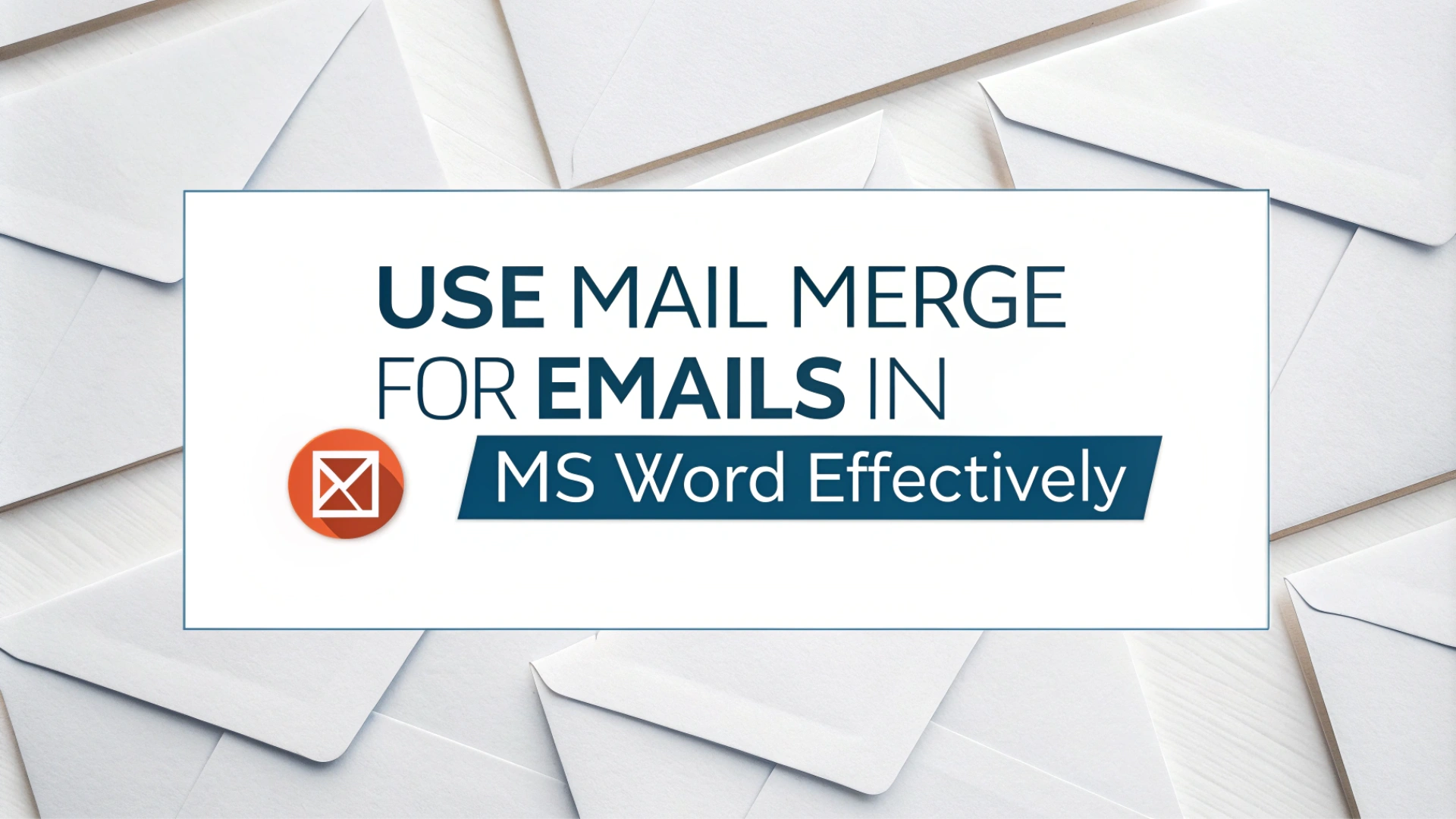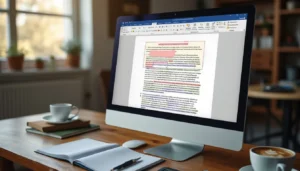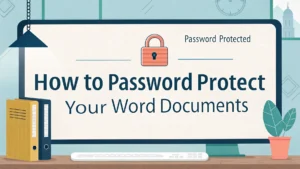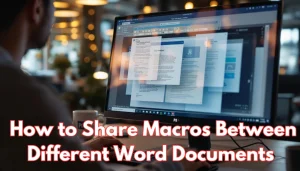Last Updated: January 23, 2025
Mail Merge in Microsoft Word enables you to send personalized emails to multiple recipients at once. This powerful feature crafts unique messages for each individual, making them feel appreciated. Imagine sending birthday cards to friends, each with a tailored note—this is the magic of Mail Merge!
To begin, compile your recipient list and draft your email in Word. Then, link your list to the email, and let Word do the work. This method not only saves time but also adds a personal touch to your communications. Let’s explore effective strategies for maximizing Mail Merge in your email campaigns!
Table Of Contents
Preparing Your Data Source for Mail Merge

To effectively use Mail Merge in Microsoft Word, preparing your data source is critical. This data source is usually a list of recipients stored in an Excel spreadsheet. Each column should represent a specific piece of information, such as initial names, last names, and email addresses, making it easy to personalize your emails.
Follow these steps to set up your data source:
- Create an Excel Spreadsheet: Open Excel and start a new sheet. Label each column with headers like “Initial Name,” “Last Name,” and “Email.”
- Enter Your Data: Fill in the rows with the relevant information for each recipient.
- Save Your File: Save the spreadsheet in an easily accessible location.
Once your data source is ready, link it to your email template in Word. Go to the Mailings tab, select Start Mail Merge, and choose Email Messages. Then, click on Select Recipients to connect your Excel file.
For in-depth guidance, check out this automation guide to streamline your workflow.
After linking, insert merge fields into your email template. These fields will automatically fill with each recipient’s information when you send the emails. This approach not only saves time but also ensures that every message feels personal and tailored.
Creating an Excel Sheet with Recipient Information
Creating an Excel sheet for recipient information starts with effective organization. Each column should represent a specific data point, such as initial name, last name, and email address.
Follow these steps to set it up:
- Open Excel: Start a new workbook.
- Label Columns: In the initial row, enter headers like “Initial Name,” “Last Name,” and “Email.”
- Input Data: Fill in recipient details in the rows below each header.
- Save Your File: Save your spreadsheet as a .xlsx file to serve as your data source.
Proper formatting is necessary. For instance, format ZIP code cells as text to keep leading zeros intact, avoiding errors when using this data for Mail Merge in Microsoft Word.
Once your list is complete, use it for different email campaigns. By merging this data with your email template, you can easily send personalized messages. For more tips on effective mail merge, check out this mail merge guide.
This method enhances your workflow efficiency, allowing you to reach multiple contacts without sending individual emails. The combination of Excel and Word streamlines document creation, improving contact management and automation.
Ensuring Data Accuracy and Formatting
To make sure data accuracy in the Mail Merge process, begin with a well-organized data source. Create a spreadsheet that includes critical information, such as names and email addresses. Proper formatting prevents issues like missing merge fields or incorrect personalization.
For example, in Excel, format ZIP codes as text to retain leading zeros, avoiding confusion. When crafting email templates in Microsoft Word, make sure each recipient’s information is accurately linked. Tools like Mail Merge streamline this process, enhancing efficiency.
After setting up your data source, insert merge fields into your email template for personalized communication, which boosts engagement. Always double-check your links to save time and prevent future hassles.
When your email is ready, use the Finish & Merge option to send bulk emails. This feature allows you to deliver individual messages to each recipient, preserving the personal touch critical in email marketing. By following these steps, you improve workflow efficiency and make sure your communications remain professional and effective.
Executing the Mail Merge Process
To execute the Mail Merge Process in Microsoft Word, start by preparing your data source. Use an Excel spreadsheet or a CSV file that lists your recipients. Each column should contain specific recipient information, such as names and email addresses.
Next, open a new document in Word. Go to Mailings > Start Mail Merge > E-mail Messages to create your email template. Insert merge fields for personalization. For instance, write, “Greetings, <
Once your email is ready, click Preview Results to see how it looks with actual data. If everything appears correct, finalize the merge by selecting Finish & Merge > Send E-mail Messages. Choose the email address column, enter a subject line, and select the email format (HTML or plain text).
This process allows you to send bulk emails efficiently, adding a personal touch that enhances your communication’s effectiveness.
Starting Mail Merge for Emails
To start mail merge for emails in Microsoft Word, click on Mailings > Start Mail Merge > Email Messages. This allows you to create personalized emails for multiple recipients at once.
Next, prepare your recipients list, which acts as your data source. You can use an Excel sheet or another database. Make sure it includes all necessary recipient information, such as names and email addresses, to customize each message effectively. For detailed guidance on setting up your data source, check this user guide.
Once your list is ready, insert merge fields into your email template. Use placeholders like <
At last, select Finish & Merge > Send Email Messages. Choose the email address field and enter a subject line. Click OK to send your messages! This efficient process boosts your email marketing effectiveness.
Sending Bulk Emails via Outlook
To send bulk emails via Outlook using Mail Merge, begin by creating your email in Microsoft Word. Go to Mailings > Start Mail Merge > E-mail Messages. Next, set up your recipients list as the data source by choosing an Excel file or your Outlook contacts. This allows you to personalize each message effectively.
In your email, insert merge fields to include names and other specific details. After composing your message, use the preview results feature to make sure accuracy. When ready, steer to Finish & Merge > Send E-mail Messages to distribute your personalized emails. For detailed instructions, check this user guide.
Summing up
Mail Merge in MS Word simplifies sending personalized emails. With a single email template, you can automatically fill in details for each recipient, saving time while adding a personal touch. Make sure your mailing list is organized and use the right fields to customize your messages effectively. This powerful tool enables you to connect with your audience meaningfully, whether for a school project or a business campaign. Begin your journey of sending personalized emails today!
Frequently Asked Questions
How to use mail merge in MS Word for email?
To use mail merge for emails in MS Word, go to Mailings > Start Mail Merge > E-mail Messages, then set up your recipient list and personalize your message.
What is the difference between email mail merging and letter mail merging as used in Word processing?
Email mail merging sends personalized emails directly, while letter mail merging creates printed documents for mailing. Simple and effective!
What are the six steps of mail merge in MS Word?
1. Start Mail Merge
2. Select Recipients
3. Write your message
4. Insert Merge Fields
5. Preview Results
6. Finish & Merge
Enjoy personalizing!
How can I customize email templates using mail merge in MS Word?
To customize email templates, insert mail merge fields in your document, then personalize content for each recipient before sending.





